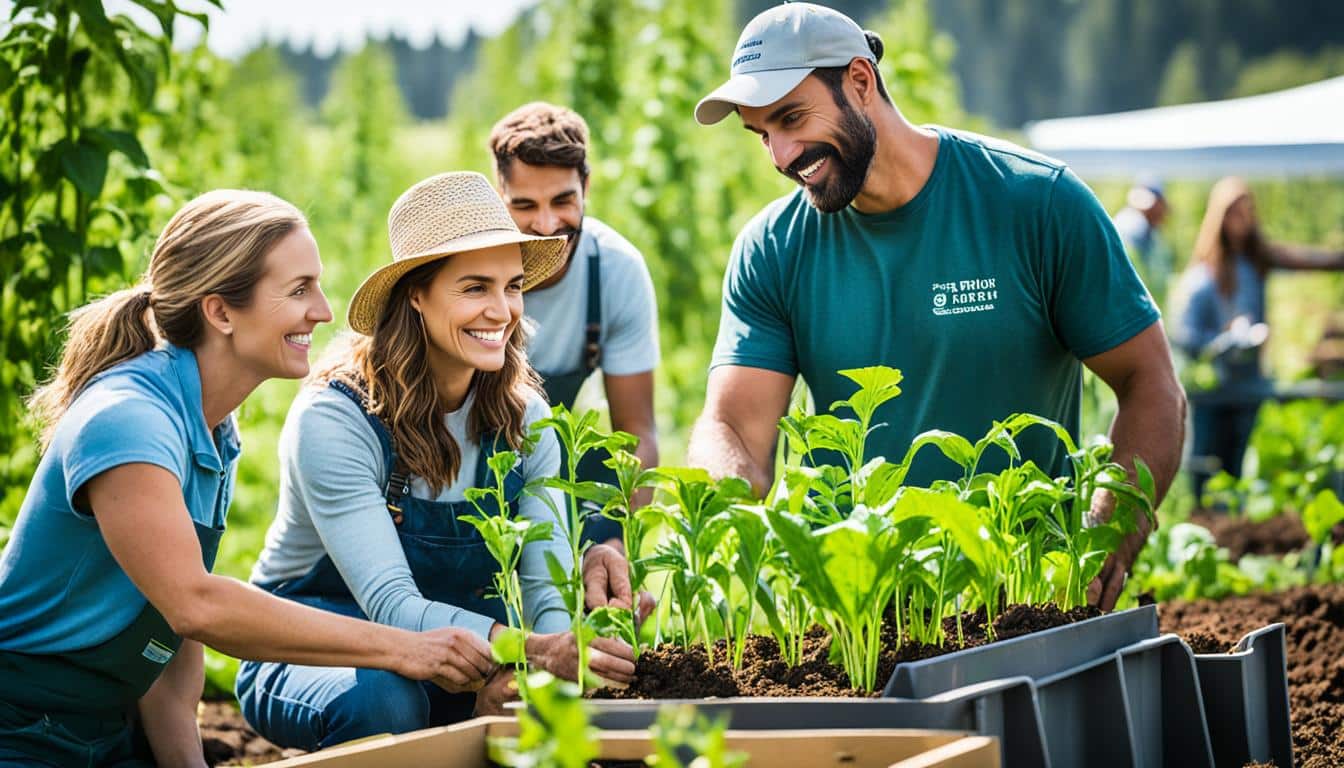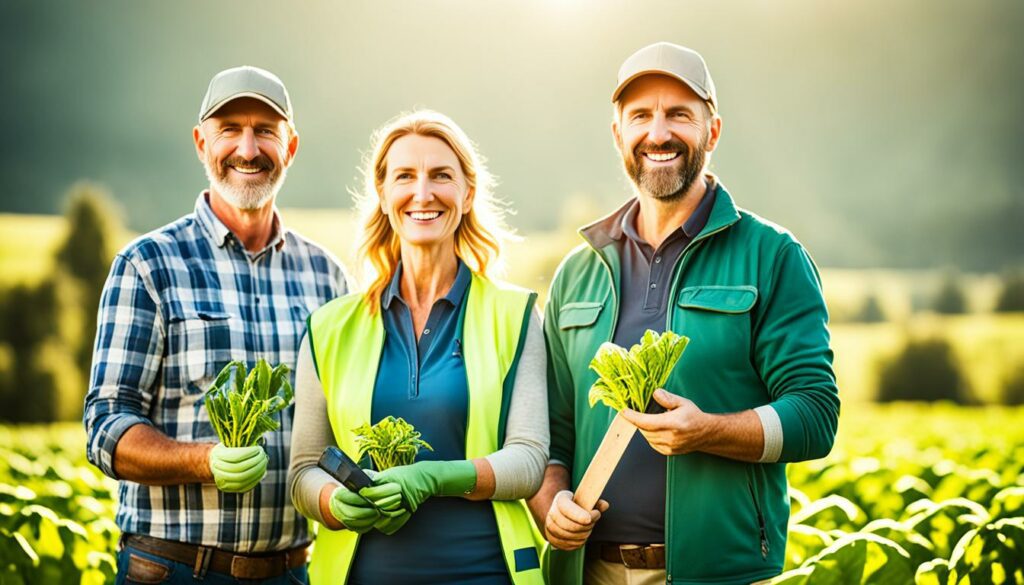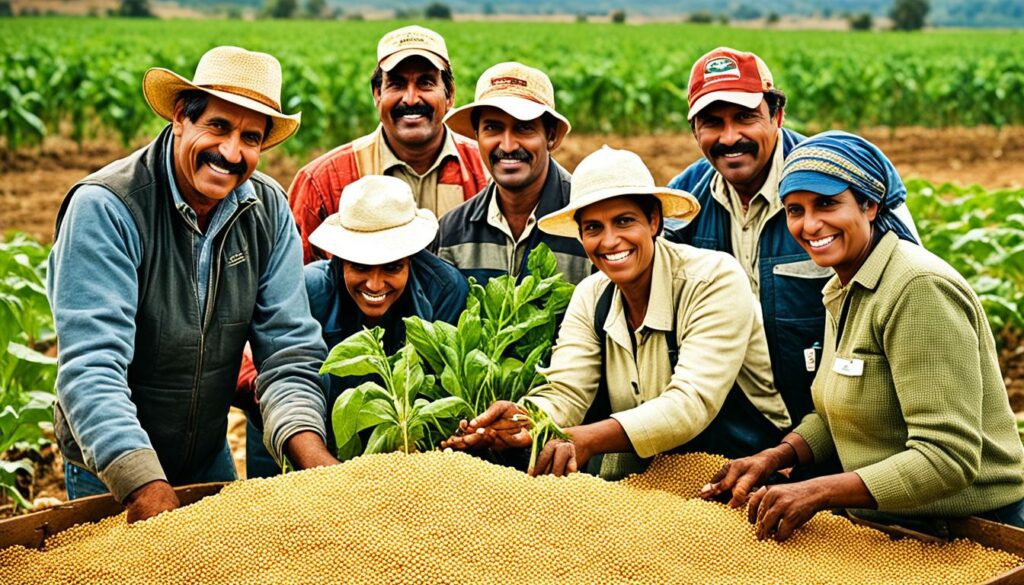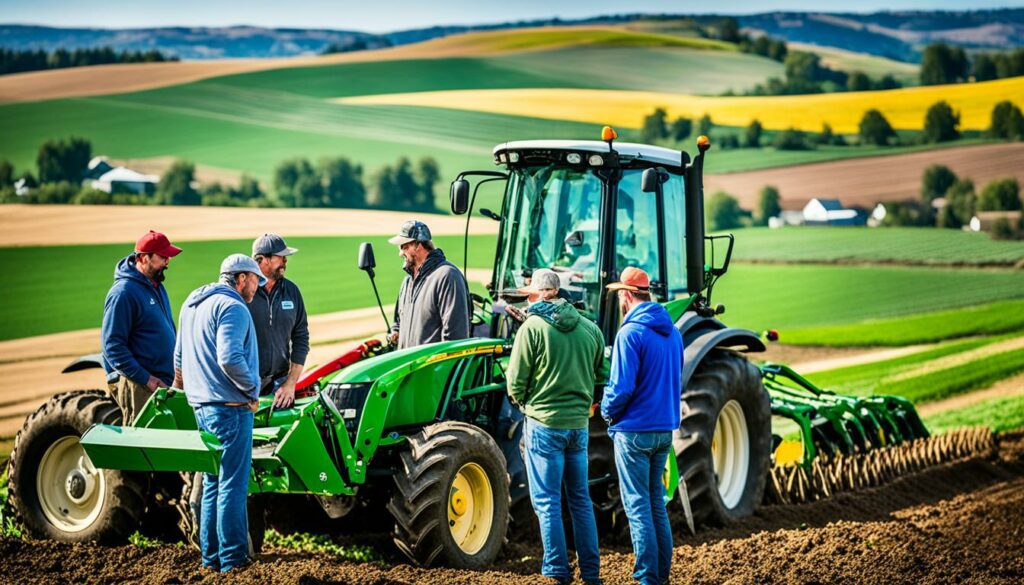Menu

Indigenous peoples have crafted advanced food systems across many generations. This shows why forming farmer networks is key. These networks allow us to access centuries of wisdom. They open doors to endless collaborations, where we combine resources and insights for a stronger, smarter agricultural world.
Farmer networks stand as vital for working across different fields. They gather a mix of skills that promote sharing and real teamwork. Exploring farming systems together helps us tackle new problems and think of better ways forward. Good leadership in these tasks is critical. It pushes for everyone’s say and helps solve issues together.
In the academic world, research teams are prime examples. There, leaders bring everyone’s work together for one goal. This team effort boosts how well we farm and lives, showing that we are stronger when we join forces. It builds a close-knit community, driven by shared dreams and support.
Farmer networks play a key role in today’s farming world. They allow farmers to share important knowledge and work together on research. These connections build strong rural community links helping farmers deal with the challenges of farming today.
These networks also help bring new ideas to life. For example, starting small in field labs and then growing to cover larger areas shows their success. The practical approach of field trials means they really work, fitting in well with how farms run.
Financial aid from such labs is also vital for buying new tools or seeds. With farming facing challenges like climate change, these connections offer a way for farmers to keep up and move forward.
Creating agricultural partnerships encourages the sharing of advice and innovation. Working together, farmers can achieve more, using each other’s strengths. Initiatives like the Ohio Ecological Food and Farming Association’s and the National Farmers Union’s training help new farmers learn essential skills from seasoned experts.
By focusing on unity and shared effort, farmer networks pave the way for agriculture’s future. They help form a lively farming community ready to tackle any obstacle.
Collaborative farming has many benefits that make farms better run and managed. It brings together the economic and social sides of farming. This results in gaining collective wisdom, boosting the peer group value, and creating strong bonds across farms.
A key advantage of collaborative farming is sharing knowledge and experiences. This unlocks a wide range of collective wisdom. Whether it’s through informal talks at places like the Copake Agricultural Center or at formal setups like the Urban Edge Farm in Providence, Rhode Island, farmers exchange insights. They discuss different techniques, challenges, and new ideas. This sharing boosts their problem-solving skills, making it easier to address tough farming problems.

In collaborative farming, peers work together to boost the peer group value. They share skills, tools, and help each other with work. For example, if they arrange to have water tanks delivered together, all involved benefit. This method reduces costs and encourages everyone to help each other, leading to better farm results.
Collaborative farming is more than just about money. It creates strong bonds across farms. These bonds offer moral support and a shared goal. Working together builds a sense of community. This helps farmers stay strong during tough times. Such social ties are key to not just surviving but thriving even in the face of hardships.
Creating a well-defined plan is key to boost teamwork and grow what farmers can do. It lays out big goals and invites everyone to join in. This way, it brings together different views and skills.
Making clear and smart goals is vital when starting an agriculture network. These goals should match the aims of farmers and the farming world. They help decide what the network will do, from short discussions to big projects.
For example, The League of Women Farmers holds its meetings in November to avoid the busy harvest time. This means more people can take part.
Knowing who the important people are is a key part of a strong network plan. Stakeholders include researchers, farmers, and advisors. It’s essential to have a mix of people with the right know-how. When starting the Willamette Women’s Farm Network, they looked from people over wide areas. They considered things like how far people would need to travel, what the weather was like, and the kind of farms folks had.
Good networks, like the LOWF, also make smaller groups. These can be about things people are interested in, like growing organically or farming particular things. These smaller groups help farmer discussions that can bring new ways to farm and sell products.
Making a network that is well-organised goes further than just being a group of farmers. It helps people feel part of a community. It also teaches and supports others and focuses on what people share. By aiming at certain groups, these networks don’t just make farming better. They also help make sure farming is done in a way that keeps the land healthy for the long term.
| Key Aspects | LOWF Example | Willamette Women’s Network Example |
|---|---|---|
| Membership | 52 in Jackson, Josephine, and Douglas counties | Diverse members across regional boundaries |
| Meeting Strategy | First meeting held in November | Mission statement guiding objectives (Page 29) |
| Key Stakeholders | Women farmers, advisors | Researchers, advisers, diverse participants |
Strategic approaches to farming cooperation are vital for a strong agricultural sector. They involve setting up shared leadership to use everyone’s knowledge well. The USDA’s big investment in projects like reducing food waste and urban farming shows that shared leadership works best. A grant of $9.4 million from NIFA for various agricultural research also proves this point.

Shared leadership means everyone has a role and a say. The USDA introduced a crop insurance scheme for specific producers, underlining the need for collective decisions. This approach stops any one person from taking over. It makes sure everyone gets to have their say and work together fairly.
Building a cooperative culture is key for the success of agriculture initiatives. It means encouraging open talks and working with everyone’s ideas. The USDA’s offer of $550 million for projects helping diverse producers shows why this culture is important. This money will create pathways for the new generation to lead, making a more welcoming atmosphere.
Plus, the USDA’s nearly $11.5 million boost in urban farming and support from 1,000 groups in innovation are great signs. Involving many people and solving problems together helps make these efforts a win for all.
| Investment Area | Funding Amount | Key Focus |
|---|---|---|
| Composting and Food Waste Reduction | $11.5 million | Urban and Rural Projects |
| Urban Agriculture and Innovative Production | $7.4 million | Urban Agriculture |
| Crop Insurance Program | Varied | Controlled Environments |
| Emerging Agricultural Production Research | $9.4 million | Urban, Indoor Agriculture |
| American Rescue Plan | Up to $550 million | Underserved Producers, Minority-Serving Institutions |
These methods clearly show how shared leadership and a cooperative culture can improve farming initiatives.
In this digital era, digital platforms are key for farmers. They help create unheard-of connections and growth. By using social media and the latest data sharing tech, farmers can improve how they interact, work together, and run their farms.
Social media is a great way to make farmer networks bigger. Studies show that using networks powered by AI and platforms like LinkedIn can boost a farmer’s connections. This includes customers, suppliers, experts, and more. Choosing the right platform is important. Facebook and Instagram are great for reaching local markets. Meanwhile, LinkedIn and Twitter are good for industry networking. Don’t forget, YouTube and blogging are great for sharing knowledge and educational content.
It’s important to share quality content with your networks. This includes photos and videos, stories, tips, and more. Engaging with your audience is key. Respond to comments and be active in groups. This builds trust and strong relationships. Also, working together with others is important. This can mean having discussions, joining forces, and participating in projects.
Data sharing tech changes how farmers connect and learn from each other. For example, tools like Climate FieldView™ use data and images from satellites to give farmers a detailed look into their farms. Aerial drones can spot crop issues like pests and diseases early. This helps farmers make smart decisions quickly.
Soil sensors in the field keep an eye on moisture and nutrients in the soil live. This helps in using resources better. Combines with smart sensors help in many ways. They optimize how farm resources are used, save fuel, lower emissions, and make planting more efficient.
It’s vital for farmers to keep learning and using the latest digital tools. Growing your online skills and network means staying up to date. Enjoying what you do online and being creative can improve the experience. This encourages farmers to share their successes and make new connections.
In conclusion, digital platforms for farmers and modern technologies are changing farming. They make farming more efficient, promote better crop care, and help with important decisions. So, modern farming is evolving, all thanks to digital platforms.
Since starting in 2020, the Regenagri programme has helped over 50,000 farmers. They’re looking after 617,464 hectares of land in a smarter way. This shows everyone’s working hard to make farming more sustainable. Thanks to Control Union, farms and supply chains follow strict rules to be more eco-friendly. This includes crops as well as materials like wool and cotton.

Solidaridad, Control Union, and Regenagri are leading a big change in farming. They want to cut down on carbon emissions and store more carbon. This will improve farming in an eco-friendlier way. The goal is to get more farms around the world to follow these better ways of farming.
Looking after the environment is key for future farms to thrive. Doing this supports a lasting bond in farming by protecting and preserving the land. Using special farming ways, like regenerative farming, helps the soil, more animals to live there, and better water use. This makes a stronger base for farmers who will come after us.
Sharing resources is crucial for sustainable farming. It can be buying things together, using machines in common, or working together with people. These ideas not only save money but also decrease harm to the environment. Working together helps farmers to be more efficient and live in better conditions in the long run.
Since 2008, about $150 million has been spent on teaching new farmers across the country. This shows a big push for working together for a better future in farming. The USDA-NIFA’s BFRDP helps new projects and creates stronger farming ways. With everyone’s effort, we build a more sustainable future in farming.
In the end, sustainable farming groups, with focus on protecting the environment and sharing wisely, are key for farming’s strength in the future. These efforts show we’re all in this together, with a common goal for a better tomorrow.
Farmer networks face common challenges. These can make their work less effective. Such problems include difficulties in working together, not sharing resources fairly, and having different goals. To tackle these, farmers must work together well. Doing so brings many good things like better money, a nicer life, and stronger links in their community.
The League of Women Farmers (LOWF) in Oregon shows successful farming teamwork. It has 52 members across Jackson, Josephine, and Douglas counties. This group helps women in farming deal with challenges and supports them. It offers a detailed guide and tools to assist.
The guide has seven important topics for farmers to work on together. It includes how to run group sessions that last 30 to 60 minutes. These sessions let farmers share what they know, talk about what works best, and solve shared problems. Plus, the guide uses flags to highlight where to find tools in the toolbox easily.
There are monthly meet-ups at places listed in the guide. These get-togethers share knowledge and make the network stronger. Also, training farmers to lead boosts the group’s success. With leadership skills, farmers can talk better, share resources fairly, and aim for shared victories.
New studies show informing farmers about the latest tech and methods improves their work. For example, in Sierra Leone, giving out new ideas and free seeds boosted the crops. Also, using mobile phones and videos have helped farmers learn new things in many places.
Working together is key. When farmers team up, they can make big improvements in how they farm. For instance, in Malawi, some farmers taught others new planting ways. Farmers with many farming friends were more likely to try these new methods. This shows how powerful sharing and learning together can be.
To wrap up, solving farming challenges means having good leaders, talking well, and sharing goals. Groups like LOWF show that overcoming these hurdles can improve farming for everyone. By coming together, farmers can find new ways to be stable economically and keep their community involved in farming.
Project leaders are key in guiding team efforts to succeed in farming networks. They pull together research, merge team work, and meet everyone’s needs. It’s important they know how to talk to people, understand them, and act professionally.

Top project leaders have great leadership skills for networking. They use their talking skills to bring everyone together, including those outside their team. They’re aware of their own preferences and see team diversity as a big plus. Because various specialities work together in farming projects, choosing the right team is crucial. This means picking people who get along and love to work together.
Relying on honest teamwork, they share their vision clearly. And they make sure everyone trusts each other. This sets up the groundwork for a solid, work-friendly atmosphere.
Keeping the team happy and on track is essential for a project leader. Good leaders value each team member and make sure their effort is noticed. They promote a leadership style where everyone has a say. This boosts team spirit and focus on what the project’s about.
Leaders also deal with many different people, from farmers to business folk. Making sure everyone works well together and gets fair pay if needed is part of their job. They’re skilled in managing groups with various viewpoints and resources. This shows just how critical they are in making farming efforts a common success.
Creating strong farmer networks helps in collaborations and innovations. Identifying the best practices for getting and keeping farmers involved is key. This way, we can effectively help each other in the community.
To build a strong network, having good recruitment methods is crucial. It’s important that our recruitment fits well with other activities and doesn’t clash with busy times. An example is the League of Women Farmers in Oregon, with 52 members. They avoid busy seasons to connect well with their members.
The LOWF has a toolkit since 2007 for creating and running farmer networks. It’s split into an instruction guide and a toolbox, covering different topics. Getting Your Network Started, Planning Your Program, Surveying Farmers, Choosing an Organisational Structure, Communicating with Your Network, Facilitating Network Meetings, and Maintaining Your Network are some of these topics. By using this toolkit, improving how we get farmers involved becomes easier.
Keeping farmer networks active needs engaging strategies. Offering monthly events, like LOWF does, is a great idea. These include farm tours, book clubs, and skill-building sessions. Such activities help farmers to become more engaged because they get involved more.
The Farmer Network Design Manual talks about involving farmers in research. This approach helps engage farmers better and ensures research reflects their needs. As we form networks, we must adjust our strategies to what farmers actually need and want.
Case studies from networks show that targeted engagement is key for success.
To sum up, building strong farmer networks needs a good plan for getting and keeping members interested. Learning from groups like LOWF can make our networks lively and helpful for all involved in agriculture.
| Metric | LOWF | Other Networks |
|---|---|---|
| Membership | 52 members | Varies |
| Established | 2007 | Varies |
| Focus Areas | Farm tours, book club, film screenings, skill-building sessions, potlucks, production classes | Research trials, efficiency studies, educational workshops |
Education plays a key role in making agricultural networking better. It gives farmers and stakeholders the skills and knowledge they need. The League of Women Farmers (LOWF) is a great example. It has 52 members in Oregon who take part in many events each month. These include farm tours, book club meetings, and skills workshops.

Improving agricultural networking is more than just getting people together. It’s about creating a culture of constant learning and growth. The LOWF provides a useful toolkit that includes a guide and toolbox. It focuses on seven important topics for running a farm network successfully. This approach helps members learn about sustainable and new farming practices.
Farmer networks help make farming more economically viable. They make life better and strengthen communities. These groups offer important education and mentoring. This helps farmers share ideas and develop new strategies for success in sustainable agriculture.
Knowing how farmers like to learn can improve how we teach them about agriculture. A survey of 94 farmers found they prefer hands-on learning the most (99%). Other popular methods include demonstrations (96%) and visiting farms (94%). Online and media like games and comics were not as well liked.
Extension agents and specialists share similar views with farmers. In a survey, they highlighted the importance of hands-on learning and farm visits. They found methods like one-on-one sessions and demos very effective. This shows that practical learning is key in agricultural education.
Groups like LOWF are crucial in making agricultural networking better by focusing on education. They keep a strong educational culture that pushes for sustainability and innovation in farming. This is important for improving both local and wider agricultural environments.
Rural community connections boost local agricultural economies. They do so by encouraging farmer partnerships. These partnerships create strong social bonds among farmers and non-farming locals, crucial for community strength.
The Appalachian Sustainable Agriculture Project in western North Carolina is a prime example. It promotes using local foods. This not only supports the community but also opens up new income sources for farmers.
Collaborations between farmers bring many economic advantages. They cut costs, make operations more efficient, and open doors to fresh markets. For example, if Montana shifted 15% of its out-of-state farm goods to local goods, farmers might earn an extra $134 million.
Moreover, these partnerships improve economic growth in the region. They foster stronger ties within the community, which is good for everyone involved.
Successful rural groups can change the game for local agriculture. Take the Montana Food Economy Initiative, which got support through SARE grants. It shows how directed help can boost farmer teamwork.
In the face of COVID-19, Midwestern farmers started ‘chaos gardens’ to help feed the hungry. This action underlined how rural bonds can be used for greater good. These examples highlight the economic and social benefits rural networks offer, aiding in their growth and preserving their communities.
Policy advocacy in agriculture is a key part of helping farmer networks deal with their many challenges. Since 1985, Farm Aid has been a leader in this work, supporting farming families facing tough times. The Farm Aid Hotline, available at 1-800-FARM-AID, runs on weekdays from 9am to 9pm Eastern Time.

It’s really important for farmers to have access to a lot of support services. Farm Aid’s Farmer Resource Network connects with over 700 groups. This kind of collaborative work is seen in projects like the Family Farm Disaster Fund which helps families hit by natural disasters.
“Homeplace Under Fire,” the documentary film, captures the efforts of farm activists in the 1980s. It shows how their work highlights the ongoing need for advocacy.
Encouraging changes in the industry is crucial to shape agriculture’s future. The Farm Advocate Link is a national network that shows how training advocates is vital. The CRFS also does important work by supporting FRNs, which are groups that work together to share and create knowledge.
| Policy Advocacy Efforts | Impact on Farmer Networks |
|---|---|
| Farm Aid Hotline | Immediate support and crisis intervention |
| Farmer Resource Network | Broad coalition of over 700 support organizations |
| Family Farm Disaster Fund | Assistance for disasters like hurricanes and wildfires |
| Farm Advocate Link | Training and support for Farm Advocates |
| Farmer Research Networks (FRNs) | Collaborative knowledge sharing and policy support |
The CRFS is all about making sure FRNs have diversity and openness. The goal of each network is to be meaningful locally, collaborative across disciplines, and open to all. They work on important issues like landscape restoration and managing pests in eco-friendly ways, supporting farmers directly.
Getting involved in policy work in agriculture is not just a smart choice; it’s crucial for helping farmers succeed. By working to change laws and rules, farmer networks can break through obstacles and get the support needed for lasting growth and strength in farming.
Advanced farming tech is changing how farmers work together. It helps build better networks using state-of-the-art tools. By 2050, with a larger global population to feed, these techs are critical, not just optional.
Precision ag tools offer farmers better insights for smarter choices. The precision farming market could hit $16.35 billion by 2028, showing rapid growth. Tools like RTK offer near-perfect accuracy, improving soil health and productivity.
Laser scarecrows have cut down crop damage by 70% to 90%, showing their importance. They are vital for today’s farming.
Blockchain boosts trust by making the supply chain open and accountable. It tracks products from farm to table, tackling risks like fraud. This helps farmers keep consumer trust and integrity, which are crucial in the market.
Integrating these techs boosts farming and makes it more sustainable and efficient for the future.
Creating inclusive farmer support systems is key in the farming world. It helps all farmers, especially those in minority groups, get a fair go. This ensures that everyone can join in and benefit from farming opportunities. It’s all about making agricultural networks open to all, matching the goal of fairness in farming.
To get minority farmers and marginalised groups involved, focused strategies are needed. Groups such as the USDA’s National Institute of Food and Agriculture (NIFA) and the Centre for Rural Futures Studies (CRFS) play a big part in this effort. NIFA, through a competitive RFA planned for FY 2025, is set to improve funding and assistance access for these groups. Also, the current operations under the FY 2023 Continuing Resolution for FRSAN keep offering solid support through regional institutions.
Tackling equity issues in farming starts with understanding past unfairness and pushing for positive change. NIFA’s process for giving out awards, involving varied reviewers from different sectors, aims for fairness. Projects that get funding must work closely with USDA-NIFA, show their results, and take part in year-end meetings to exchange useful strategies. This way, the goal of fairness and inclusion is met through clear and responsible steps, promoting teamwork and learning.
Farmer networks help in many ways. They encourage working together on research and sharing leadership. With farmer networks, everyone supports each other.
These networks mix different experts to solve farming problems. They also help spread new, creative ways to farm. This makes farming better for everyone.
Connections in rural areas are very important. They help share information and support each other. This strengthening of partnerships makes farms more resilient.
It also helps rural areas economically and socially. By working together, everyone’s situation can improve.
Sharing experiences and best practices makes farmers better at solving problems. It helps them find new, smart ways to deal with issues. As a result, farming gets more effective and successful.
Working closely with other farmers in networks is key. It allows for better problem-solving. This can lead to clearer, better solutions. It makes things like delivering water to fields more efficient.
Connecting farms has two big pluses. First, it saves money through sharing. Second, it boosts morale and a sense of togetherness. This helps make rural life more rewarding and sustainable.
Having clear goals sets the network on the right path. It ensures everyone’s efforts aim at the same objectives. This results in a focused and effective network.
Selecting the right people is crucial. It means choosing farmers and others who have the needed knowledge and are eager to work together. This helps ensure a strong and varied network.
Shared leadership is crucial. It means drawing from everyone’s knowledge and ensuring an inclusive decision-making process. This way, the network becomes a true team effort.
Encouraging open communication is step one. Then, making sure everyone has a say in decisions. This approach builds a culture where all work towards common goals.
Digital platforms are great for real-time communication. They make it easier to connect and share ideas across distances. This includes using social media for networking.
Using technology for sharing data boosts a network’s abilities. It provides quick, important insights and supports joint problem-solving. This means better decisions and operations on the farm.
Sustainable farming means protecting the land and its resources for the future. It ensures farms can keep going strong. This is good for the farms and the environment.
Strategies like buying supplies together or sharing equipment reduce costs. They cut down on waste too. Through this, farms work together for a greener, more efficient future.
Strong leadership and clear goals are vital. They make sure everyone moves in the same direction. This boosts the network’s power and unity.
Project leaders need to be great communicators and understand people well. They should be able to bring everyone together towards common aims. This ensures the network achieves great things together.
Leaders keep teams happy and focused by making each member feel important. They show how everyone’s efforts are part of the larger success. This motivates the team towards their objectives.
The best way to bring people in is through targeted outreach. This gets a diverse and qualified group involved. They can make a real difference in the network.
Engagement should meet farmers’ specific needs. It should encourage them to play an active, valuable role. Understanding what motivates them is key.
Education prepares people to work effectively together. It gives them the tools to make a difference in the network and in their community. This leads to improvements for all in agriculture.
Working together saves money and opens up new markets. This boosts the living standards in rural areas. It makes the business of farming more financially healthy.
Many examples show how coming together makes local economies stronger. They talk about better use of resources and more involvement from the community.
Getting involved in advocating for the right policies helps networks grow and thrive. It opens doors and removes obstacles. This ensures their long-term success.
Precision tools let farmers use their resources wisely. They make decisions based on solid data. This makes their work more efficient within the network.
Blockchain guarantees that we know where our food comes from. It builds trust and encourages cooperation in networks. Farmers and consumers alike can rely on this tech.
Engaging overlooked groups means addressing past injustices. It’s about making sure everyone has a fair chance. This creates a network where all can fully participate.
To achieve fairness, we must actively create equal opportunities. This makes a network where everyone is welcome. Diverse voices strengthen and enrich the agricultural world.